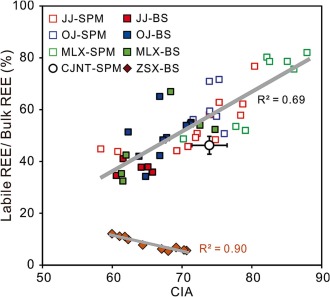Yulong Guo a, *, Yalong Li a, b, Shouye Yang a
a, State Key Laboratory of Marine Geology, Tongji University, Shanghai 200092, China
b, School of Environmental and Geographical Sciences, Shanghai Normal University, Shanghai 200233, China
Abstract:
Weathering indices derived from bulk sediment geochemistry are inevitably affected by inherited signatures from recycled sedimentary rocks. Therefore, characterizing and evaluating the impacts of sedimentary recycling be comes critically important. The proportion of labile REEs in river sediments holds promise in meeting this requirement. This is because the presence of labile REEs are primarily influenced by processes associated with present-cycle weathering, including the release of REEs through the dissolution of primary REE-bearing minerals, the formation of secondary minerals, and the simultaneous adsorption of REEs. Sediments from small catchments in Southeast China, featuring diverse climatic, geological settings, and weathering regimes, are utilized to establish and validate this potential weathering index.The chemical labile fractions of sediment samples were separated by 1 N HCl leaching. For sediments from catchments in Southeast mainland China, characterized by Mesozoic granitoid source rocks, the proportions of labile REEs are notably high, ranging from 32 % to 82 %, and show a significant positive correlation with CIA values. The main hosts for the labile REEs in these sediments are absorbed phase by clay minerals and/or Fe-Mn (hydro)oxides. In contrast, for sediments from the Zhuoshuixi catchment in Taiwan, which originate from recycled sedimentary and metasedimentary rocks, the proportions of labile REEs are much lower, around 8 %, and exhibit a negative correlation with CIA values. In these sediments, the dissolution of MREE-bearing minerals is likely the main source of labile REEs. Compared to weathering indices based on bulk sediment geochemistry, the proportion of labile REEs can indicate weathering intensity over a broader range of W/D values and can largely avoid interference from sedimentary recycling. Overall, our results reaffirm that earth surface processes, including chemical weathering and hydrodynamic sorting, may effect the REE distribution in the labile phase and even the bulk sediment. This factor must be fully considered when using REEs as sediment provenance tracers.
Full article:https://www.sciencedirect.com/science/article/pii/S0921818125001729

Fig. Labile REE/ Bulk REE (%) versus CIA diagrams for river sediments.

